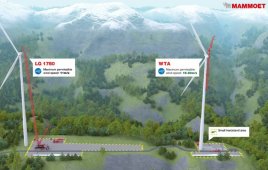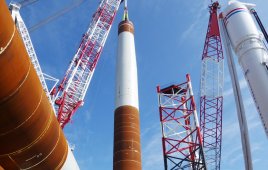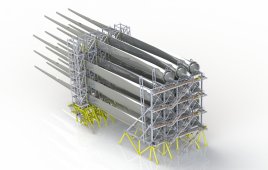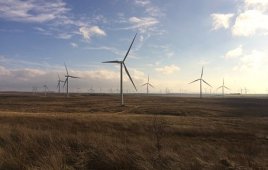The trend toward longer turbine blades means greater energy capture at lower wind speeds. However, with bigger blades comes increased weight and stress on the adhesive bond line. Polyurethane adhesives can improve the long-term performance of future blades while reducing total manufacturing cost.
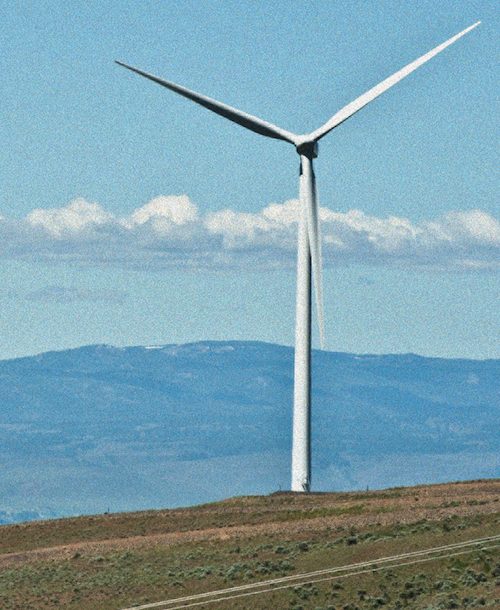
Made essentially of laminated glass-reinforced plastic, today’s rotor blades can be almost 61-m long and weigh up to 15 metric tons. This challenges adhesive strength and durability.
To boost energy yield, rotor blades are becoming larger and heavier. The longest production blades can span about 61-m and weigh 15 metric tons. Future designs call for lengths of 80 to 100 m and beyond. They are primarily polymer composite structures (e.g. glass-reinforced plastic) expected to last at least 20 years in a challenging service environment. When rotor blade tips slice through the air at speeds up to 300 km per hour, it’s not hard to imagine the extreme stresses they must withstand.
The trend toward larger, stronger, heavier blades is expected to continue because such designs will deliver more energy. In addition, the area available to capture wind is greater, making the turbine more efficient at lower wind speeds.
But as blade length increases, stresses on the blade are magnified. Larger blades experience more deflection across the length of the blade, increasing the dynamic load and stress on the adhesive bond line. Adhesives that offer superior long-term dynamic fatigue strength will provide better performance over the blade’s life and lower the risk of damage that requires repair or replacement.
Along with the need to improve performance, wind-turbine manufacturers must also lower their total production cost. Wind-equipment manufacturers work diligently to shorten production cycles and lower overall time and turbine production costs. Also, manufacturers are evaluating options to make reductions in lengthy production cycle times. Shorter cycle times translate into capital, labor, utility, and overhead savings, while also allowing greater flexibility in meeting unplanned demands.

Henkel Macroplast UK 1340, represented in blue, bonds the spar in place and the leading and trailing edges of the blade assembly.
Traditional blade assembly
There are two fundamentally different approaches to rotor-blade construction. Non-self supporting structures involve a box spar with an aerodynamic profile. Self-supporting structures consist of two blade halves with bonded spars that transmit all forces. The structural bonding of self-supporting blades requires adhesives with exceptional mechanical properties.
Regardless of size or construction, the quality of a rotor blade depends upon the reliability of its adhesive bonds. Glass-reinforced plastic rotor blades are fabricated in a simple sandwich design. Two blade halves are created in a composite mold. After demolding, the two halves are mated and bonded together to form the rotor blade.
The bonded blade construction is exposed to long-term direct loading. If the bond fails under stress, the blade may be damaged or even ruptured. For this reason, Germanischer Lloyd (GL) approval for blade bonding adhesives is only awarded after an adhesive passes numerous physical parameter checks.
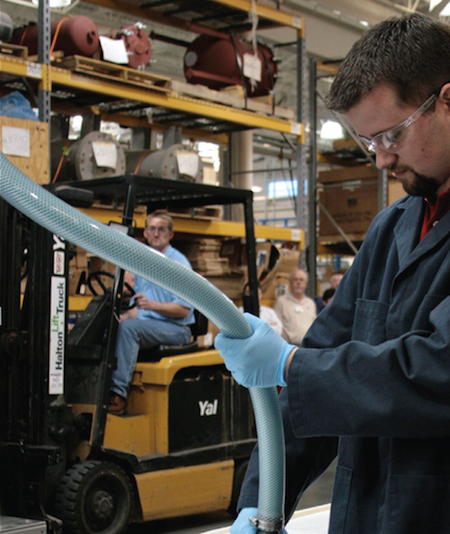
A technician applies Macroplast UK 1340, a polyurethane adhesive that speeds rotor blade production and reduces costs by 15 to 30%. Offering breakthrough Tg better than typical polyurethanes, it is the only adhesive in its class to satisfy GL’s requirements.
Until recently, self-supporting structures such as rotor blades have been typically bonded with GL-certified two-component reactive epoxy resins. Widely accepted in the aerospace industry for structural bonding applications, epoxies offer excellent adhesion, tensile strength, and chemical and heat resistance. Limitations include extended cure times, high exotherm, and higher process costs.
Two-part epoxy adhesives are thermoset materials that cure using heat, or heat with pressure. Used for high-load assemblies and in severe service conditions, cured thermoset adhesives may soften when heated, but do not melt or flow.
Epoxies begin curing once the two parts are mixed, but require substantial time to cure completely. The total cure involves several heat-cure cycles and can last in excess of 24 hours. Longer cycle times limit a manufacturer’s throughput and result in elevated work-in-progress inventories, decreased mold use, and increased energy costs associated with cure ovens.
Epoxies also generate extreme heat, greater than 120 to 150ºC, when curing. This naturally-occurring heat can cause the bond line to swell during cure, and then shrink as it cools, which leads to stress building in the blade assembly. This stress can translate into a concentration that causes cracks under dynamic loading. Furthermore, epoxies can be inherently brittle, which limits the blades’ resistance to crack propagation. Also, epoxies can become more brittle over time, so the likelihood of cracking, especially under dynamic loads, may increase.
These limitations increase the risk for warranty claims, loss of production, and finally increased maintenance cost and blade failure. With the new manufacturing requirements for larger blades, epoxyies are reaching their limits for bonding blades.
An advanced polyurethane
A recent polyurethane (PUR) adhesive satisfies specific mechanical requirements for use in the wind industry while improving the long-term reliability of rotor blades and making rotor-blade production faster and less expensive. The material, Macroplast UK 1340 from Henkel Corp., contributes to the assembly of highly efficient wind turbines.
Because of a large spectrum of possible polymer architectures, polyurethane adhesives have been employed as a bonding agent in many different industrial sectors for more than 30 years. Construction, automotive, transportation, and shipping vessels have all benefited from the use of polyurethanes.
The recent polyurethane adhesive provides superior dynamic fatigue strength and increased resistance to crack propagation, while making the production of rotor blades more efficient than with epoxy technology. For instance, the PUR adhesive requires fewer curing steps than epoxies, resulting in reduced production costs and production cycles that are 15 to 30% shorter.
In addition to blade bonding, the two-component polyurethane adhesive is also used in other structural bonding applications on turbines including bonding components to the rotor blade, performing field repairs of blades, and securing various components inside the tower assembly.
GL’s requirements for the adhesive primarily relate to its tensile shear strength, long-term durability, creep behavior, and glass transition. The adhesive’s physical properties are temperature-dependent. Within a temperature range known as glass transition (Tg), the change in the adhesive’s mechanical properties is considerable. The glass-transition temperature separates the lower, brittle, or glass range from the upper, flexible, or rubbery-elastic range.
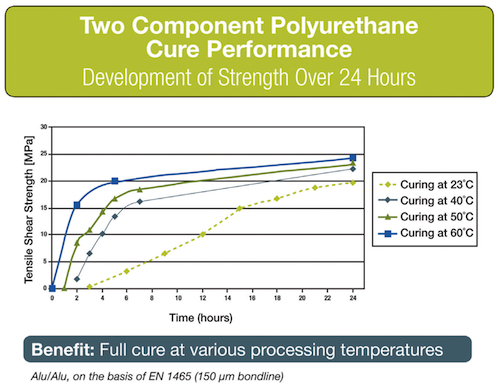
Extensive tests demonstrate a tensile shear strength for Macroplast UK 1340 exceeding 20 MPa in the -40 to +80°C temperature range and a Tg of 65°C and higher.
For turbine rotor blades, a Tg of at least 65°C is required to prevent bond creep or relative movement of the substrates, and achieve a certain degree of rigidity at higher ambient temperatures. However, for typical polyurethane adhesives this is usually within the range of only -30 to 45°C, depending on the required elasticity.
Tests have demonstrated a tensile shear strength exceeding 20 MPa in the -40 to +80°C temperature range for the material and a Tg of 65°C and higher. This improved tensile fatigue strength lets wind blades handle the deflection across the length of the blade and the dynamic load and stress on the adhesive bond line better than epoxies, thereby reducing the risk of damage that may require repair or replacement. The two-component polyurethane adhesive consists of a resin and a hardener. After mixing, pot life ranges from 60 to 80 minutes at the optimal ambient temperature of 20°C. The reaction speed of polyurethane-based adhesives can be altered, for considerably decreased time spent to produce rotor blades.
The two-component polyurethane adhesive consists of a resin and a hardener. After mixing, pot life ranges from 60 to 80 minutes at the optimal ambient temperature of 20°C. The reaction speed of polyurethane-based adhesives can be altered, for considerably decreased time spent to produce rotor blades.
The adhesive’s pot life can adapt as required for a specific manufacturer’s production without the disadvantage of partially overheating the adhesive joint. Manufacturers can maximize throughput without the risk of elevated stress in the part or the potential cracking associated with high exotherm.
The recent PUR adhesive cures at a much lower reaction temperature of up to 75°C maximum when compared to epoxies that cure at 120 to150ºC. Reducing the exothermic reaction benefits the process in two ways. First, when bonding composite materials, stress cracking caused by excessive thermal loading may weaken the rotor blade. This risk is significantly reduced when the reaction temperature is lower.
Second, polymerization that takes place at high temperatures is always accompanied by changes in volume. Low-heat emission and lower thermal loading during chemical crosslinking reduces heat-related shrinkage of the adhesive. Shrinkage in the bond line can increase internal stresses, hence, a controlled shrinkage results in a more durable bond over time. The heat generated from an exothermic reaction will vary depending on the quantity of adhesive undergoing cure. In areas where larger amounts of adhesive are applied, temperatures get much hotter than in areas with less adhesive volume.
On a single rotor blade, there are considerable differences in the quantity of adhesive applied and, therefore, considerable differences in stress. At interfaces between such stress fields, mechanical flaws will occur unless the stress is relieved through elaborate tempering. This is where polyurethane systems with low-temperature exothermic reactions have big advantages, particularly when applied in thick films.
Adhesives that address the higher dynamic load and stress associated with larger blades will provide better performance over the life of the blade and lower the risk of damage that may require repair or replacement.
Adhesives that cure at room temperature and those which cure rapidly at elevated temperatures can shorten production cycles, and reduce the overall time and cost of turbine production. Room temperature curing adhesives eliminate the need for ovens, while faster curing adhesives improve throughput during the blade bonding assembly process.
Compared to conventional epoxy resin systems, the latest polyurethane delivers a number of improvements for wind-turbine manufacturers. The adhesive’s shorter cycle times boost productivity while reducing energy costs. It provides superior tensile and fatigue strength, and resists crack propagation, meeting high standards of reliability and quality.
Dr. Michael Gansow, Corp. Dir. PUR Development
Jason Spencer, Business Manager
Thomas Buckley, Market Application Engineer
Henkel Corp.
www.henkelna.com/windpower
WPE
Filed Under: Blades, Construction

